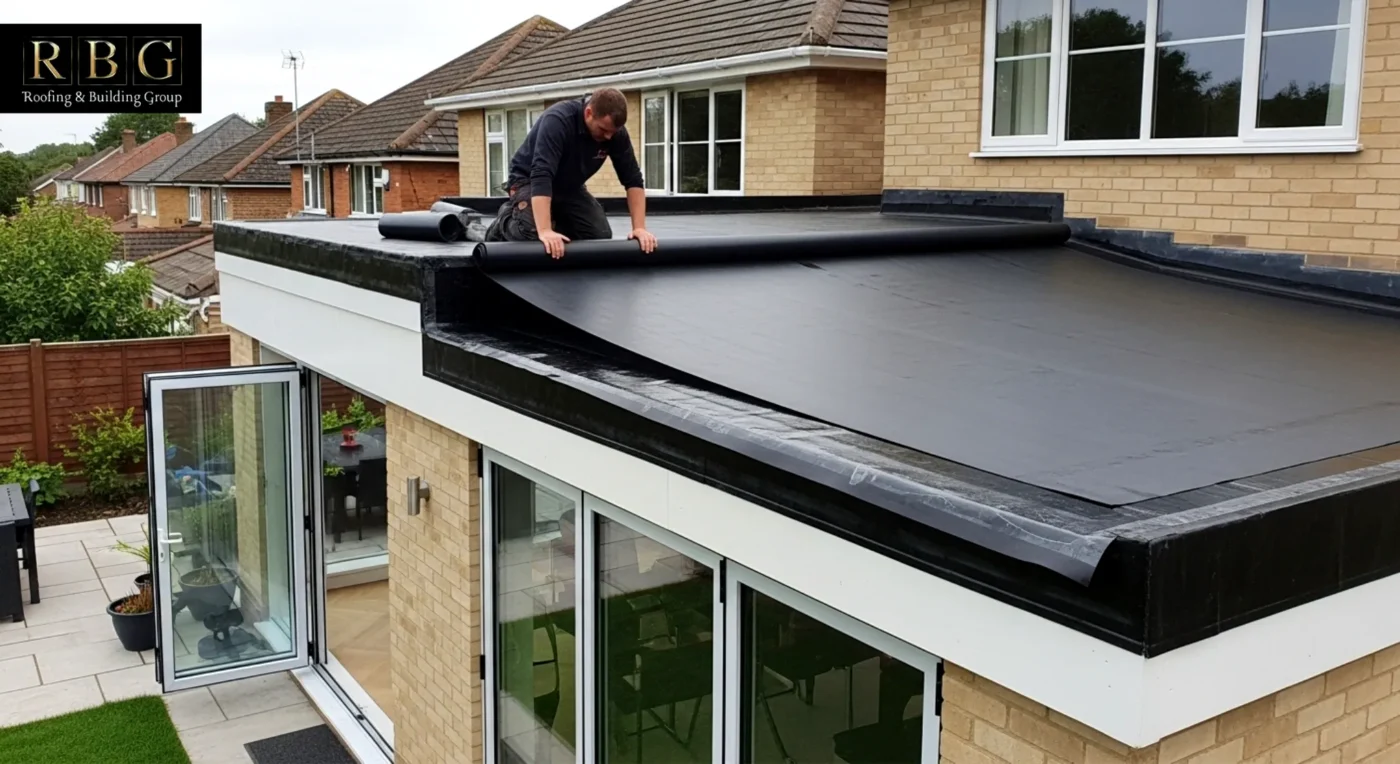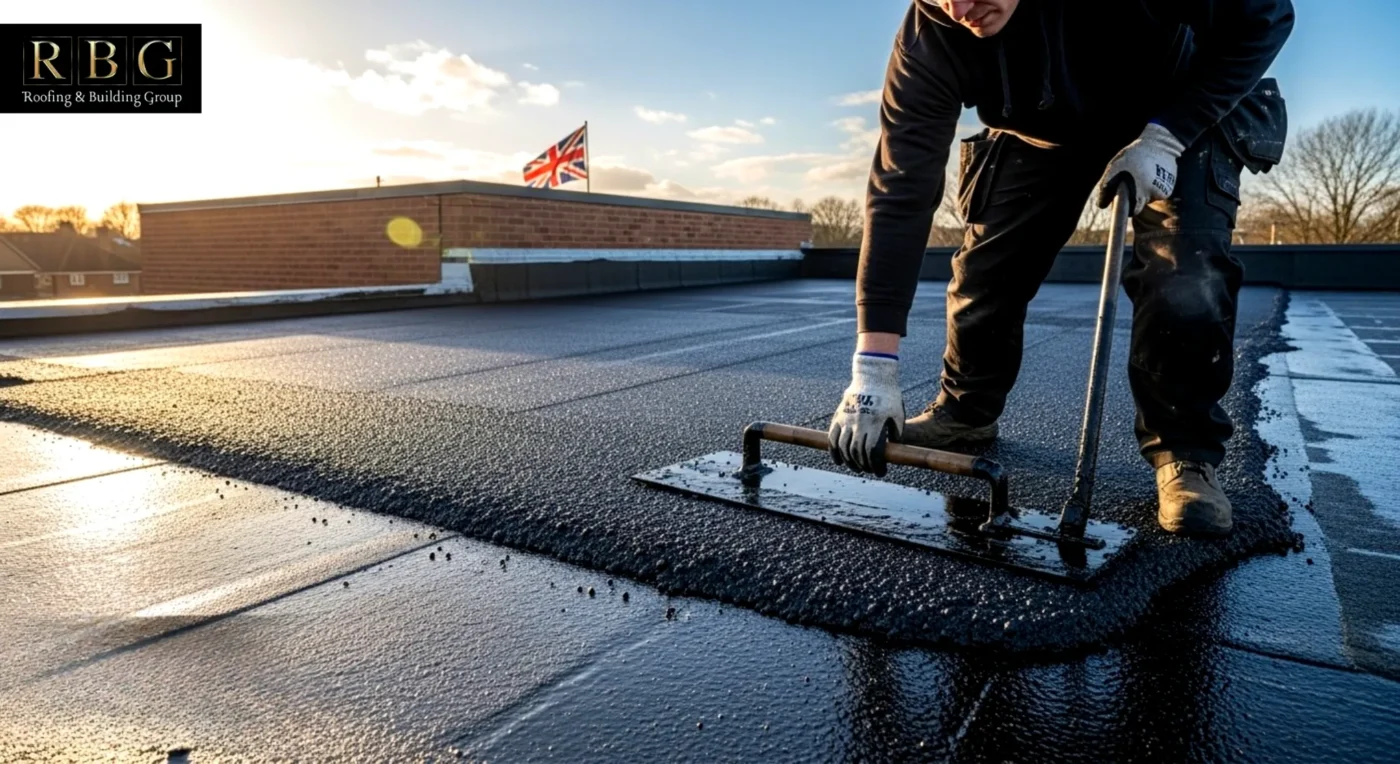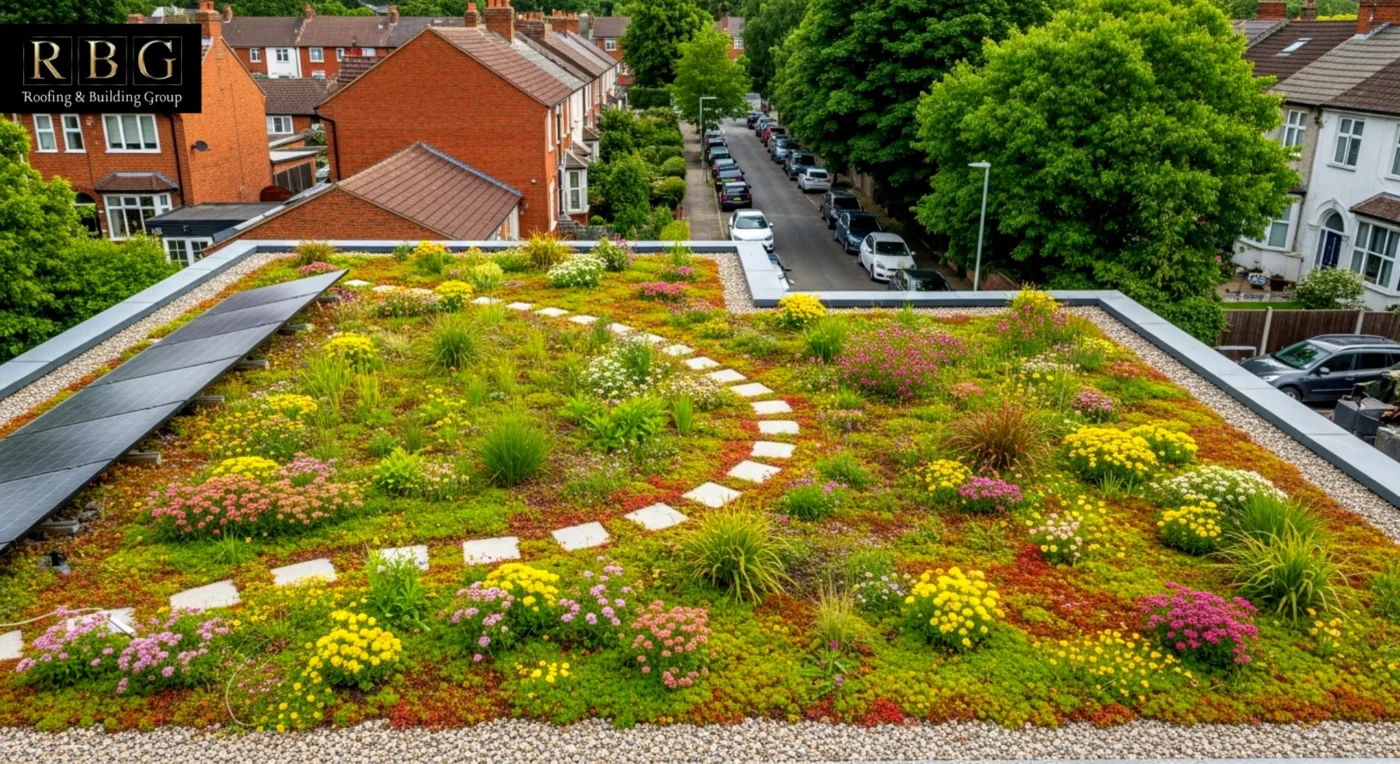Choosing the best flat roof material for your property can be a tricky task. It’s essential to consider factors such as your local climate, the size of your roof, and your long-term objectives. Whether you’re seeking a durable solution or aiming for a modern aesthetic, the proper flat roof covering can make all the difference.
As an expert roofing contractor at RBG Roofing and Building in the Forest of Dean area, we will share our experience and knowledge on the best flat roofing materials, taking into account local weather conditions and other relevant factors. Now let’s explore the different types of flat roof materials available in the UK, including their pros and cons. We’ll help you make an informed decision by guiding you through the best options for cost-effective, long-lasting, and reliable flat roof materials.
Types of Flat Roof Materials
Choosing the right flat roof material is crucial, as each type offers its own set of benefits, costs, and suitability for different needs. The material you choose should align with your budget, local climate, and the specific performance you expect from your roof. Whether you’re looking for a new roof installation, replacing an old one, or upgrading your current roof, understanding your options is essential.
Common flat roof materials in the UK include felt roofing, EPDM rubber, and GRP fibreglass. Each of these materials offers distinct advantages, including durability, low maintenance, and energy efficiency. In the following sections, we’ll dive into these options to help you find the best flat roof material for your home or business.
Felt Roofing (Bitumen Felt)

Average Lifespan
Felt roofing tops typically last between 10 and 15 years, depending on the quality of the materials and the level of maintenance. Higher-quality felt can last closer to the 15-year mark, while lower-end options may need to be replaced sooner.
Cost Range
Felt roofing is one of the most cost-effective flat roofing solutions available. The price typically ranges from £60 to £80 per square meter. If insulation is required, costs can rise to around £130 per square meter.
Best Uses
Felt roofing is best suited for small structures, such as garages, sheds, and extensions. It’s also suitable for residential buildings when combined with proper seasonal roof maintenance and additional layers. Due to its waterproofing properties, it is often used for roofs that require a quick, affordable solution.
Pros and Cons
Pros:
- Affordable and cost-effective
- Easy to install with both DIY and professional options
- Waterproof and weather-resistant
- Minimal maintenance required
Cons:
- Shorter lifespan compared to other materials (10-15 years)
- Vulnerable to extreme weather (heat, cold, and heavy rainfall)
- Repairs can be unsightly, especially if they need to be patched up
- The installation process for torch-on can be hazardous if not done properly
EPDM Rubber Roofing

Average Lifespan
EPDM roofing is known for its long lifespan, typically lasting between 30 and 50 years with proper maintenance. The lifespan may vary depending on weather conditions, the quality of installation, and the level of maintenance.
Cost Range
EPDM is a cost-effective flat roofing material, generally priced between £50 and £90 per square meter. Its affordable installation costs, combined with a long lifespan, make it a popular choice for both residential and commercial properties.
Best Uses
EPDM roofing is ideal for flat roofs, especially in areas exposed to extreme weather conditions. It is commonly used for residential properties, garages, offices, and workshops. Its seamless design and high durability make it suitable for roofs of all sizes and shapes, even those with complex designs. Additionally, EPDM is often used in green roofs due to its excellent waterproofing properties and resistance to root penetration.
Pros and Cons
Pros:
- Durable and long-lasting (up to 50 years)
- Weather-resistant, withstands extreme temperatures and UV exposure
- Low maintenance and easy installation without heat or flames
- Flexible and resistant to shrinkage, making it suitable for various roof sizes and shapes
- Cost-effective compared to other high-end roofing materials
Cons:
- Appearance may not appeal to everyone, as the rubber membrane typically lacks the aesthetic appeal of other materials
- Vulnerable to damage from sharp objects like falling branches or debris if the membrane is not thick enough
- May suffer from shrinkage or tenting in extreme conditions, which can lead to leaks if not properly maintained
GRP Fibreglass Roofing

Average Lifespan
GRP fibreglass roofs are incredibly durable, with a lifespan of 20 to 30 years when properly maintained. Some high-quality installations, such as Cure It GRP, can even last up to 50 years, providing long-term reliability for your property.
Cost Range
The cost of GRP roofing typically ranges from £70 to £100 per square meter. Prices may vary depending on the type of fibreglass used, the complexity of the roof, and any additional materials or services required for installation.
Best Uses
GRP fibreglass is ideal for flat roofs of all sizes and shapes, making it suitable for both residential and commercial properties. It is commonly used for extensions, garages, workshops, and balconies. Its versatility also makes it an excellent choice for roof overlays or complex roof shapes, as it can be easily moulded to fit intricate designs.
Pros and Cons
Pros:
- Durable with a long lifespan of 20-30 years
- Weather-resistant and can withstand extreme temperatures
- Seamless design eliminates the risk of leaks
- Safe installation, as it requires no heat or flames
- Low maintenance with minimal repairs needed
Cons:
- Costlier than some other roofing options, though it offers excellent value for money over its lifespan
- Appearance may not appeal to everyone, as the fibreglass finish can look industrial or utilitarian
- Installation requires expertise, especially for larger or more complex roofs
- Potential for damage from falling debris if the membrane is not thick enough
Liquid Flat Roofing Systems

Average Lifespan
Liquid flat roofs are known for their long lifespan, with most systems lasting 30-35 years, depending on the material used. Liquid rubber coatings, for example, can last over 30 years, making them a great long-term investment for homeowners and businesses alike.
Cost Range
The cost of liquid flat roofing systems typically ranges from £60 to £100 per square meter, depending on the type of liquid applied (e.g., GRP fibreglass, liquid plastic, or liquid rubber). While the initial cost is relatively affordable, their durability ensures that you get great value for money over time.
Best Uses
Liquid flat roofs are highly versatile and can be used for both new installations and existing roofs. They are ideal for flat roofs on residential homes, commercial buildings, garages, and extensions. The liquid coating can be applied directly onto the surface without disturbing the existing structure, making it an excellent option for roof repairs or replacements.
Pros and Cons
Pros:
- Easy installation with minimal disruption, no need for heat or flames
- Suitable for all weather conditions and can be applied year-round
- Durable and long-lasting, offering excellent value for money
- Cost-effective compared to other high-end materials
- Tensile strength and elasticity help prevent cracks and damage over time
Cons:
- Aesthetic concerns: Some may not prefer the appearance of the liquid coating compared to more traditional materials
- Potential for wear in high-traffic areas if not properly maintained
- Requires expertise for proper application to ensure long-lasting results
- Not suitable for steep roofs—best for flat or low-slope applications
Mastic Asphalt Roofing

Average Lifespan
Mastic asphalt is renowned for its exceptional durability, boasting a lifespan of over 50 years when properly maintained. Its robust composition makes it one of the longest-lasting roofing materials available, often outlasting other flat roof systems by decades.
Cost Range
Mastic asphalt roofing typically ranges between £80 and £120 per square metre, depending on the roof size and specific installation requirements. While it is a more expensive option upfront, its long lifespan and low maintenance costs offer excellent long-term value.
Best Uses
Mastic asphalt is suitable for both new buildings and refurbishments, as well as existing structures. It is ideal for flat roofs on residential and commercial buildings, providing a smooth, waterproof coating. Its versatility also makes it perfect for tight spaces and areas where other materials might struggle to fit, such as floors or intricate roof designs.
Pros and Cons
Pros:
- Exceptional durability with a lifespan of over 50 years
- Weather-resistant, can withstand extreme temperatures and harsh weather conditions
- Great thermal shock resistance, enhancing energy efficiency in your home
- Flexible and can be moulded to fit various roof shapes and spaces
- Low maintenance with long warranty periods, minimising repair costs
Cons:
- Higher initial cost compared to other flat roofing materials
- Installation requires expertise to ensure the asphalt is laid correctly
- Appearance may not appeal to everyone due to its more industrial look
- Heavy material that may require extra structural support in some cases
Green Roof Alternatives

Average Lifespan
Green roofs are incredibly durable and can last 40 to 50 years with proper maintenance. The lifespan depends on the type of plants used, the quality of installation, and the prevailing climate conditions. Some well-maintained green roofs can even last longer, making them a sustainable choice for the long term.
Cost Range
The cost of green roofing typically ranges from £60 to £120 per square meter, depending on the type of green roof system (e.g., sedum, wildflower mix), the complexity of installation, and the required drainage systems. Although the initial investment can be higher compared to traditional flat roofing materials, green roofs provide long-term benefits that justify the cost.
Best Uses
Green roofs are ideal for residential and commercial buildings looking to increase their energy efficiency and create eco-friendly spaces. They are particularly beneficial for urban areas, helping to reduce the urban heat island effect. Green roofs are also ideal for flat roofs on offices, garages, and community spaces, where their insulation and aesthetic benefits can be fully utilised.
Pros and Cons
Pros:
- Eco-friendly and sustainable, reducing CO2 emissions and supporting wildlife habitats
- Energy-efficient, offering natural insulation that keeps buildings cool in summer and warm in winter
- Soundproofing qualities, protecting against noise from traffic, aircraft, and heavy rainfall
- Aesthetic appeal, turning unused roof space into a garden-like area
- Low maintenance, as many systems are self-sufficient and require no irrigation
Cons:
- Higher initial cost due to the installation complexity and required drainage systems
- Not suitable for all climates—may require specific conditions or additional support in harsher climates
- Maintenance may be necessary to ensure plant health and address potential drainage issues
- Installation can be complex, requiring specialised knowledge and expertise for the best results
Final Thoughts on Flat Roof Types
Choosing the right flat roof material depends on your budget, climate, and the specific needs of your property. Whether you go for cost-effective felt roofing, long-lasting EPDM, or sustainable green roofs, each option has its own benefits. Before selecting the type of flat roof material to use for your home, it’s always best to consult with local roofers for advice. If you want professional roofing services in the Forest of Dean and its surrounding areas, you can contact RBG Roofing and Building Group.
FAQ’s
What is the best material for a flat roof in the UK?
The best flat roof material in the UK depends on your budget and needs. EPDM rubber is highly durable and weather-resistant, while GRP fibreglass offers strength and a seamless finish. Felt roofing is an affordable option, making it a popular choice for budget-conscious homeowners.
What is the longest-lasting flat roof material?
EPDM rubber is one of the longest-lasting flat roof materials, with a lifespan of up to 50 years when properly maintained. GRP fibreglass can also last for 30-50 years, providing excellent durability and low maintenance over time.
What is the best covering for a flat roof?
The best covering for a flat roof depends on your priorities. EPDM rubber offers excellent weather resistance and longevity. For an eco-friendly option, green roofs provide natural insulation and aesthetic appeal. GRP fibreglass is another popular choice for its strength and seamless finish.
What are the three types of flat roofs?
The three main types of flat roofs are built-up roofs (BUR), single-ply membranes (such as EPDM and TPO), and liquid-applied coatings (like GRP). Each type offers different benefits in terms of durability, cost, and installation methods.
What is the cheapest flat roof replacement?
The cheapest flat roof replacement option is generally felt roofing. It’s affordable, easy to install, and widely available. However, its lifespan is shorter compared to other materials, such as EPDM or GRP fibreglass, making it a budget-friendly short-term solution.

